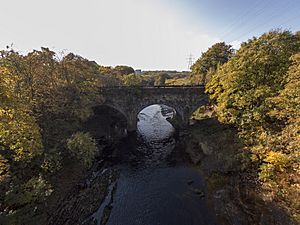Clifton Aqueduct facts for kids
Quick facts for kids Clifton Aqueduct |
|
|---|---|

The aqueduct spanning the Irwell, as viewed from the Clifton Viaduct downstream
|
|
| Coordinates | 53°31′40″N 2°19′02″W / 53.5277°N 2.3172°W |
| OS grid reference | |
| Carries | Manchester, Bolton and Bury Canal |
| Crosses | River Irwell |
| Locale | Clifton, Greater Manchester |
| Heritage status | Grade II |
| Characteristics | |
| Trough construction | Stone |
| Pier construction | Brick |
| Towpaths | Both |
| Number of spans | Three |
| History | |
| Designer | Charles Roberts and John Nightingale |
| Construction end | 1796 |
The Clifton Aqueduct is a historic bridge built in 1796. It was designed to carry the Manchester Bolton & Bury Canal over the River Irwell. You can find it in Clifton, near Manchester, England.
This amazing structure is made from strong stone and brick arches. It has three main arches that help it cross the river. The aqueduct is so important that it is protected as a Grade II listed structure. This means it's a special building that should be preserved.
Contents
What is an Aqueduct?
An aqueduct is like a bridge that carries water. In this case, the Clifton Aqueduct carried a canal, which is a man-made waterway. Canals were very important long ago for moving goods and people by boat.
How the Clifton Aqueduct was Built
The Clifton Aqueduct was built by two engineers, Charles Roberts and John Nightingale. They used strong, cut stone for the main parts. The arches were made of brick.
- It has three curved arches.
- These arches rest on strong supports in the river.
- There are flat, decorative columns on the sides.
- A brick wall, called a parapet, is on the eastern side.
The aqueduct also has paths on both sides for horses to pull boats. These paths are called towpaths. You can still see grooves in the aqueduct. These were for special planks that could be put in place to drain the canal if needed.
Why is the Clifton Aqueduct Important?
The Clifton Aqueduct is one of only two aqueducts left on the original canal route. The other one is the Prestolee Aqueduct. These structures show us how clever engineers were hundreds of years ago. They helped connect towns and cities, making trade and travel much easier.
The Canal's Future
The Manchester Bolton & Bury Canal is currently being restored. People hope that boats will be able to use the canal again soon. However, as of late 2020, the Clifton Aqueduct does not have water flowing through it. The canal around it is also very overgrown and looks a bit worn out.
Visiting the Aqueduct
If you want to see the Clifton Aqueduct, the closest train station is Clifton (Manchester) railway station. It's a great place to learn about history and engineering.

